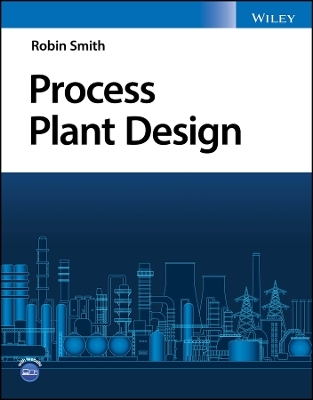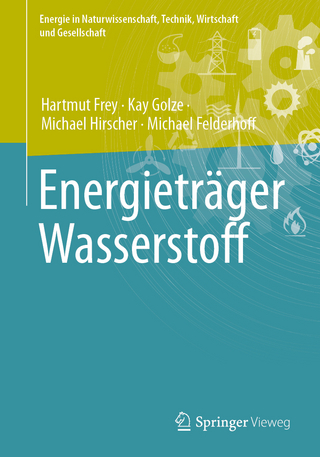
Process Plant Design
John Wiley & Sons Inc (Verlag)
978-1-119-68991-1 (ISBN)
Process Plant Design provides an introductory practical guide to the subject for undergraduate and postgraduate students of chemical engineering, and practicing chemical engineers.
Process Plant Design starts by presenting general background from the early stages of chemical process projects and moves on to deal with the infrastructure required to support the operation of process plants.
The reliability, maintainability and availability issues addressed in the text are important for process safety, and the avoidance of high maintenance costs, adverse environmental impact, and unnecessary process breakdowns that might prevent production targets being achieved.
A practical approach is presented for the systematic synthesis of process control schemes, which has traditionally received little attention, especially when considering overall process control systems.
The development of preliminary piping and instrumentation diagrams (P&IDs) is addressed, which are key documents in process engineering.
A guide is presented for the choice of materials of construction, which affects resistance to corrosion, mechanical design and the capital cost of equipment.
Whilst the final mechanical design of vessels and equipment is normally carried out by specialist mechanical engineers, it is still necessary for process designers to have an understanding of mechanical design for a variety of reasons.
Finally, Process Plant Design considers layout, which has important implications for safety, environmental impact, and capital and operating costs.
To aid reader comprehension, Process Plant Design features worked examples throughout the text.
Process Plant Design is a valuable resource on the subject for advanced undergraduate and postgraduate students of chemical engineering, as well as practicing chemical engineers working in process design. The text is also useful for industrial disciplines related to chemical engineering working on the design of chemical processes.
Professor Robin Smith is Professor of Chemical Engineering at the University of Manchester. Before joining the University of Manchester he gained extensive industrial experience with different companies in process investigation, production, process design, process modelling and process integration. He has co-founded three spin-out companies from the University of Manchester and has acted extensively as a consultant to industry. He is a Fellow of the Royal Academy of Engineering, a Fellow of the Institution of Chemical Engineers in the UK and a Chartered Engineer. He has published widely in the field of process integration and is author of “Chemical Process Design and Integration”, published by Wiley. He was awarded the Hanson Medal of the Institution of Chemical Engineers, UK for his work on waste minimization, and the Sargent Medal for his work on process integration.
Preface xi
Acknowledgments xiii
Nomenclature xv
About the Companion Website xix
1 Chemical Process Projects 1
1.1 The Process Plant Design Problem 1
1.2 Continuous and Batch Processes 2
1.3 New Design and Retrofit 3
1.4 Hazard Management in Process Plant Design 4
1.5 Project Phases 4
1.6 Chemical Process Projects – Summary 5
References 6
2 Process Economics 7
2.1 Capital Cost Estimates 7
2.2 Class 5 Capital Cost Estimates 8
2.3 Class 4 Capital Cost Estimates 9
2.4 Class 3 to Class 1 Capital Cost Estimates 15
2.5 Capital Cost of Retrofit 15
2.6 Annualized Capital Cost 16
2.7 Operating Cost 17
2.8 Economic Evaluation 20
2.9 Investment Criteria 23
2.10 Process Economics − Summary 23
Exercises 24
References 25
3 Development of Process Design Concepts 27
3.1 Formulation of Design Problems 27
3.2 Evaluation of Performance 27
3.3 Optimization of Performance 28
3.4 Approaches to the Development of Design Concepts 29
3.5 Screening Design Options 32
3.6 Influencing the Design as the Project Progresses 33
3.7 Development of Process Design Concepts – Summary 34
References 35
4 Heating Utilities 37
4.1 Process Heating and Cooling 38
4.2 Steam Heating 39
4.3 Water Treatment for Steam Generation 44
4.4 Steam Generation from the Combustion of Fuels 45
4.5 Steam Generation from Electrical Energy 48
4.6 Gas Turbines 50
4.7 Steam Turbines 51
4.8 Steam Distribution 55
4.9 Steam Heating Limits 64
4.10 Fired Heaters 64
4.11 Other Heat Carriers 68
4.12 Heating Utilities – Summary 74
Exercises 74
References 76
5 Cooling Utilities 77
5.1 Waste Heat Steam Generation 77
5.2 Once-Through Cooling Water Systems 77
5.3 Recirculating Cooling Water Systems 78
5.4 Air Coolers 80
5.5 Refrigeration 82
5.6 Choice of a Single Component Refrigerant for Compression Refrigeration 88
5.7 Mixed Refrigerants for Compression Refrigeration 89
5.8 Absorption Refrigeration 93
5.9 Indirect Refrigeration 93
5.10 Cooling Utilities − Summary 94
Exercises 95
References 96
6 Waste Treatment 97
6.1 Aqueous Emissions 97
6.2 Primary Wastewater Treatment Processes 101
6.3 Biological Wastewater Treatment Processes 104
6.4 Tertiary Wastewater Treatment Processes 109
6.5 Atmospheric Emissions 109
6.6 Treatment of Solid Particulate Emissions to Atmosphere 111
6.7 Treatment of VOC Emissions to Atmosphere 114
6.8 Treatment of Sulfur Emissions to Atmosphere 120
6.9 Treatment of Oxides of Nitrogen Emissions to Atmosphere 123
6.10 Treatment of Combustion Emissions to Atmosphere 124
6.11 Atmospheric Dispersion 127
6.12 Waste Treatment − Summary 128
Exercises 128
References 129
7 Reliability, Maintainability, and Availability Concepts 131
7.1 Reliability, Maintainability, and Availability 131
7.2 Reliability 133
7.3 Repairable and Non-repairable Systems 136
7.4 Reliability Data 139
7.5 Maintainability 141
7.6 Availability 143
7.7 Process Shut-down for Maintenance 144
7.8 Reliability, Maintainability, and Availability Concepts − Summary 145
Exercises 145
References 146
8 Reliability, Maintainability, and Availability of Systems 147
8.1 System Representation 147
8.2 Reliability of Series Systems 147
8.3 Reliability of Parallel Systems 149
8.4 Availability of Parallel Systems 153
8.5 Availability of Series Systems 153
8.6 Redundancy 156
8.7 k-out-of-n Systems 159
8.8 Common Mode Failure 161
8.9 Capacity 166
8.10 Reliability, Availability, and Capacity 169
8.11 Monte Carlo Simulation 169
8.12 Reliability, Maintainability, and Availability of Systems − Summary 172
Exercises 172
References 174
9 Storage Tanks 175
9.1 Feed, Product, and Intermediate Storage 175
9.2 Intermediate (Buffer) Storage and Process Availability 177
9.3 Optimization of Intermediate Storage 181
9.4 Storage Tanks − Summary 182
Exercise 182
References 183
10 Process Control Concepts 185
10.1 Control Objectives 185
10.2 The Control Loop 185
10.3 Measurement 186
10.4 Control Signals 187
10.5 The Controller 187
10.6 Final Control Element 191
10.7 Feedback Control 195
10.8 Cascade Control 197
10.9 Split Range Control 198
10.10 Limit and Selector Control 200
10.11 Feedforward Control 201
10.12 Ratio Control 204
10.13 Computer Control Systems 205
10.14 Digital Control 207
10.15 Safety Instrumented Systems 210
10.16 Alarms and Trips 211
10.17 Representation of Control Systems 211
10.18 Process Control Concepts – Summary 215
Exercise 215
References 216
11 Process Control – Flowrate and Inventory Control 217
11.1 Flowrate Control 217
11.2 Inventory Control of Individual Operations 217
11.3 Inventory Control of Series Systems 223
11.4 Inventory Control of Recycle Systems 226
11.5 Flowrate and Inventory Control – Summary 227
References 228
12 Process Control – Degrees of Freedom 229
12.1 Degrees of Freedom and Process Control 229
12.2 Degrees of Freedom for Process Streams 231
12.3 Individual Single-Phase Operations 233
12.4 Heat Transfer Operations with No Phase Change 237
12.5 Pumps and Compressors 241
12.6 Equilibrated Multiphase Operations 243
12.7 Control Degrees of Freedom for Overall Processes 246
12.8 Degrees of Freedom – Summary 256
Exercises 256
References 257
13 Process Control – Control of Process Operations 259
13.1 Pump Control 259
13.2 Compressor Control 262
13.3 Heat Exchange Control 267
13.4 Furnace Control 271
13.5 Flash Drum Control 274
13.6 Absorber and Stripper Control 274
13.7 Distillation Control 278
13.8 Reactor Control 291
13.9 Control of Process Operations – Summary 301
Exercises 301
References 302
14 Process Control – Overall Process Control 303
14.1 Illustrative Example of Overall Process Control Systems 303
14.2 Synthesis of Overall Process Control Schemes 310
14.3 Procedure for the Synthesis of Overall Process Control Schemes 311
14.4 Evolution of the Control Design 323
14.5 Process Dynamics 324
14.6 Overall Process Control – Summary 325
Exercises 325
References 328
15 Piping and Instrumentation Diagrams – Piping and Pressure Relief 329
15.1 Piping and Instrumentation Diagrams 329
15.2 Piping Systems 330
15.3 Pressure Relief 335
15.4 Relief Device Arrangements 338
15.5 Reliability of Pressure Relief Devices 341
15.6 Location of Relief Devices 345
15.7 P&ID Piping and Pressure Relief – Summary 346
Exercises 346
References 348
16 Piping and Instrumentation Diagrams – Process Operations 349
16.1 Pumps 349
16.2 Compressors 355
16.3 Heat Exchangers 359
16.4 Distillation 361
16.5 Liquid Storage 366
16.6 P&ID Process Operations – Summary 373
Exercises 373
References 374
17 Piping and Instrumentation Diagrams – Construction 375
17.1 Development of Piping and Instrumentation Diagrams 375
17.2 A Case Study 376
17.3 P&ID Construction – Summary 387
References 387
18 Materials of Construction 389
18.1 Mechanical Properties 389
18.2 Corrosion 392
18.3 Corrosion Allowance 393
18.4 Commonly Used Materials of Construction 393
18.5 Criteria for Selection of Materials of Construction 397
18.6 Materials of Construction – Summary 398
References 398
19 Mechanical Design 399
19.1 Stress, Strain, and Deformation 399
19.2 Combined Stresses 423
19.3 Spherical Vessels Under Internal Pressure 426
19.4 Cylindrical Vessels Under Internal Pressure 428
19.5 Design of Heads for Cylindrical Vessels Under Internal Pressure 431
19.6 Design of Vertical Cylindrical Pressure Vessels Under Internal Pressure 434
19.7 Design of Horizontal Cylindrical Pressure Vessels Under Internal Pressure 439
19.8 Buckling of Cylindrical Vessels Due to External Pressure and Axial Compression 445
19.9 Welded and Bolted Joints 448
19.10 Opening Reinforcements 451
19.11 Vessel Supports 453
19.12 Design of Flat-bottomed Cylindrical Vessels 462
19.13 Shell-and-Tube Heat Exchangers 463
19.14 Mechanical Design – Summary 464
Exercises 465
References 467
20 Process Plant Layout − Site Layout 469
20.1 Site, Process, and Equipment Layout 469
20.2 Separation Distances 470
20.3 Separation for Vapor Cloud Explosions 472
20.4 Separation for Toxic Emissions 477
20.5 Site Access 477
20.6 Site Topology, Groundwater, and Drainage 479
20.7 Geotechnical Engineering 481
20.8 Atmospheric Discharges 481
20.9 Wind Direction 482
20.10 Utilities 483
20.11 Process Units 483
20.12 Control Room 483
20.13 Ancillary Buildings 485
20.14 Pipe Racks 485
20.15 Constraints on Site Layout 487
20.16 The Final Site Layout 487
20.17 Site Layout − Summary 487
References 487
21 Process Plant Layout − Process Layout 489
21.1 Process Access 489
21.2 Process Structures 489
21.3 Hazards 492
21.4 Preliminary Process Layout 492
21.5 Example – Preliminary Process Layout 493
21.6 Process Layout – Summary 498
References 498
Appendix A Weibull Reliability Function 499
Appendix B MTTF for the Weibull Distribution 501
Appendix C Reliability of Cold Standby Systems 503
Reference 504
Appendix D Corrosion Resistance Table 505
Appendix E Moment of Inertia and Bending Stress for Common Beam Cross-Sections 509
E.1 Solid Rectangular Cross-Section 509
E.2 Hollow Rectangular Cross-Section 509
E.3 Solid Circular Cylinder 510
E.4 Hollow Circular Cross-Section 511
E.5 Approximate Expressions for Thin-Walled Cylinders 511
Appendix F First Moment of Area and Shear Stress for Common Beam Cross-Sections 513
F.1 Solid Rectangular Cross-Section 513
F.2 Hollow Rectangular Cross-Section 513
F.3 Solid Circular Cross-Section 514
F.4 Hollow Circular Cross-Sections 515
Reference 515
Appendix G Principal Stresses 517
Appendix H Dimensions and Weights of Carbon Steel Pipes 521
Appendix I Bending Moment on Horizontal Cylindrical Vessels Resulting from a Liquid Hydraulic Head 525
References 526
Appendix J Equivalent Cylinder Approximation 527
Index 529
| Erscheinungsdatum | 13.12.2023 |
|---|---|
| Verlagsort | New York |
| Sprache | englisch |
| Maße | 216 x 279 mm |
| Gewicht | 1389 g |
| Themenwelt | Naturwissenschaften ► Chemie ► Technische Chemie |
| Technik ► Maschinenbau | |
| ISBN-10 | 1-119-68991-0 / 1119689910 |
| ISBN-13 | 978-1-119-68991-1 / 9781119689911 |
| Zustand | Neuware |
| Informationen gemäß Produktsicherheitsverordnung (GPSR) | |
| Haben Sie eine Frage zum Produkt? |
aus dem Bereich


